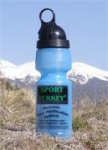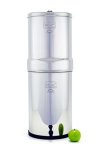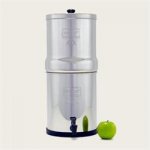Safecastle
Emergency Essentials Store
World leader in portable water filtration
Berkey water filter systems come in several different models, all shown on this page for comparison. Each model was engineered with a specific set of guidelines in mind. The most important factor to consider is the number of people that the specific Berkey water filter model would be able to supply drinking water for. A second factor is, how would you be using the filter? Would you be using the water filter system to supply just drinking water or would the water from the Berkey also be needed for hygiene and cooking purposes? Finally would you be using the Berkey system for everyday use or only in emergencies? All models produce the same quality of water (purified). The difference between the models is the amount of water that they are able to produce per hour and the size of the storage container.
Members who signup for our Loyalty program save even more. Members save extra
For several years, Berkey Water Filters could not be shipped to California residents. This limitation was due to somewhat ambiguous regulations that went into effect January 1, 2010. The regulations were not only vague but the related requirements also made it very costly, if not impossible, for smaller companies to comply with the regulations that were unique to the state of California.

Summer Traveler's Special

$246

Sports Berkey
The Sport Berkey Portable Water Filter is the ideal personal protection traveling companion - featuring the IONIC ADSORPTION FILTRATION SYSTEM.

$37.00

Crown Berkey Water Filters
The Crown Berkey is our largest purifier model and is ideal for use with very large sized groups (40-150 people) at home, churches, hospitals and orphanages.

$325

Imperial Berkey
This versatile purifier model is the ideal system for use with large sized groups 25-75 people, at home, churches, hospitals, and orphanages.

$310.00

Royal Berkey Water Filters
Versatile purifier model ideal for home use and large-sized families (from 4 to 26 people) or during emergencies.

$283

Berkey water filter systems come in several different models, all shown on this page for comparison. Each model was engineered with a specific set of guidelines in mind. The most important factor to consider is the number of people that the specific Berkey water filter model would be able to supply drinking water for. A second factor is, how would you be using the filter? Would you be using the water filter system to supply just drinking water or would the water from the Berkey also be needed for hygiene and cooking purposes? Finally would you be using the Berkey system for everyday use or only in emergencies? All models produce the same quality of water (purified). The difference between the models is the amount of water that they are able to produce per hour and the size of the storage container.
Members who signup for our Loyalty program save even more. Members save extra
For several years, Berkey Water Filters could not be shipped to California residents. This limitation was due to somewhat ambiguous regulations that went into effect January 1, 2010. The regulations were not only vague but the related requirements also made it very costly, if not impossible, for smaller companies to comply with the regulations that were unique to the state of California.
- Sports Berkey
- Travel Berkey
- Berkey Lights (with or without LED lights

Summer Traveler's Special
Berkey is offering a Summer Traveler's Special. For a limited time, with the purchase of a Travel Berkey® system, a free generic Sport Berkey® Portable Water Filter will be included.
Buy travel berkey & get sports berkey FREE !!
Buy travel berkey & get sports berkey FREE !!

The compact Travel Berkey® system is the perfect system for use during travel & any outdoor activities or during unexpected emergencies.
The Travel Berkey® system removes pathogenic bacteria, cysts & parasites entirely & extracts harmful chemicals such as herbicides, pesticides, VOCs, organic solvents, radon 222 & trihalomethanes.
It also reduces nitrates, nitrites & unhealthy minerals such as lead and mercury.
Travel Berkey Filters
The Travel Berkey® system removes pathogenic bacteria, cysts & parasites entirely & extracts harmful chemicals such as herbicides, pesticides, VOCs, organic solvents, radon 222 & trihalomethanes.
It also reduces nitrates, nitrites & unhealthy minerals such as lead and mercury.
Travel Berkey Filters

Sports Berkey
The Sport Berkey Portable Water Filter is the ideal personal protection traveling companion - featuring the IONIC ADSORPTION FILTRATION SYSTEM.

$37.00

Crown Berkey Water Filters
The Crown Berkey is our largest purifier model and is ideal for use with very large sized groups (40-150 people) at home, churches, hospitals and orphanages.

$325

Imperial Berkey
This versatile purifier model is the ideal system for use with large sized groups 25-75 people, at home, churches, hospitals, and orphanages.

$310.00

Royal Berkey Water Filters
Versatile purifier model ideal for home use and large-sized families (from 4 to 26 people) or during emergencies.

$283


